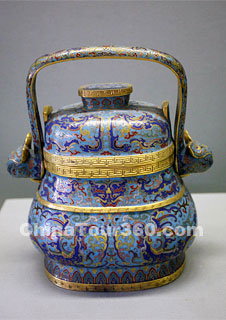 |
| Chinese Cloisonne |
Cloisonne is typically called the 'Blue of Jingtai' as blue is the dominant color adopted for enameling and Cloisonne became prevalent during the reign of Jingtai (1450-1456) in the Ming Dynasty (1368 - 1644). It is made through quite elaborate and complicated processes: base-hammering, soldering, enamel-filling, enamel firing, polishing and gilding.
![]() Procedure of Cloisonne-Making
Procedure of Cloisonne-Making
1. Base-Hammering
This is, in fact, the work of a coppersmith. As copper is easily hammered and stretched, it is employed to make the body of Cloisonne. A sound judgment is required because this expertise determines the uniformity of thickness and weight. In contrast to the work of a coppersmith which is ended when the article is shaped, base-hammering is just the beginning.
2. Filigree Soldering
The second step can be compared to embroidery, as both require great care and high creativity. The only difference is that instead of embroidering on silk, the Cloisonne craftsman adhibits copper strips onto the copper body. 1/16 inch in diameter, these strips are shaped into what the artisan requires, usually a complicated but complete pattern. With a blueprint in mind, the craftsman exerts his experience and imagination in setting the copper strips on the body.
3. Enamel Filling

A Cloisonne Pot
Then comes enamel filling, which requires the application of such basic elements as boric acid, saltpeter and alkaline. Due to the different minerals added, Cloisonne appears different in color. Usually one with an excess of iron will turn gray; with uranium, yellow; with chromium, green; with bronze, blue; with zinc, white; and with gold or iodine, red. After the ores have been ground into fine powder and contained in plates, workers apply them to the small compartments separated by filigrees.
4. Enamel Firing
As you put the article to the crucible - in a moment the copper body will turn red. When firing, re-fillings are repeatedly required as the enamel in the small compartments will sink slightly after firing.
5. Polishing
To make the filigree and the filled compartments even, the artisan must then polish the half finished products again and again. First emery is used. Then the whole piece re-fired again and then a whetstone is employed for polishing. In the end, a piece of hard carbon is rubbed on the surface areas in order that the article will obtain some luster on the surface.
6. Gilding
Lastly, the article is placed in a bath of gold or silver fluid to which is applied changing electric current so as to keep it free from rust. Finally another electroplating and a slight polish are demanded for the exposed parts of the filigree and the metal fringes of the article.







